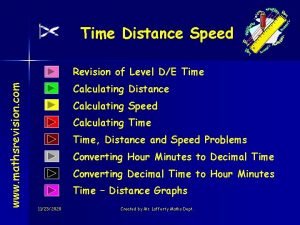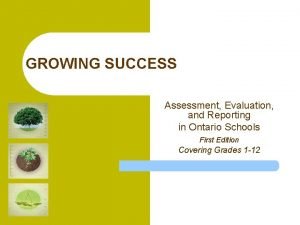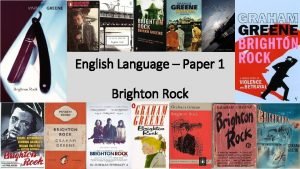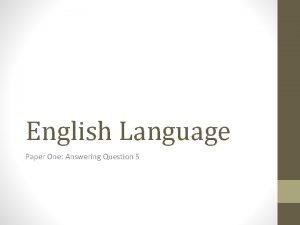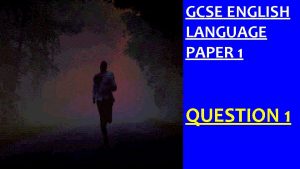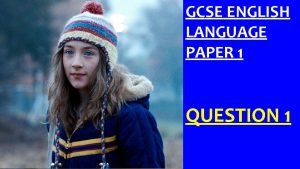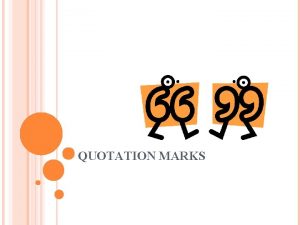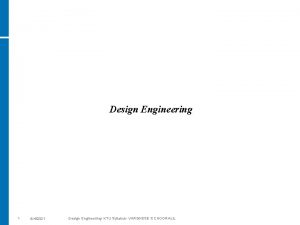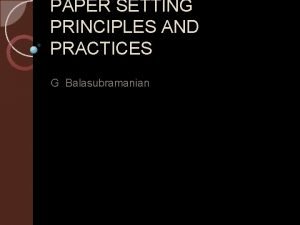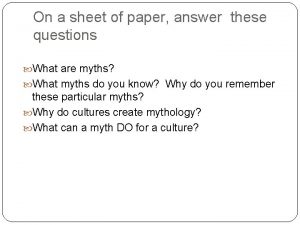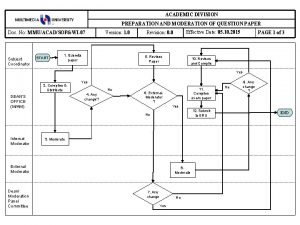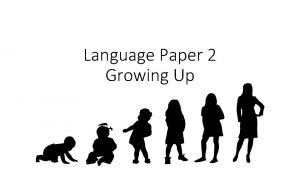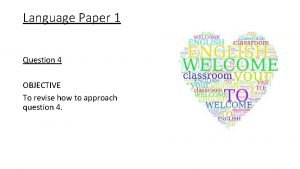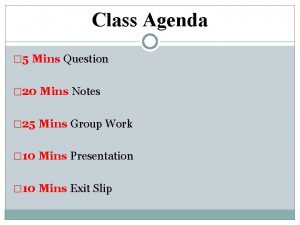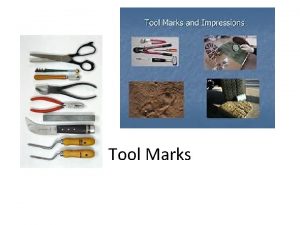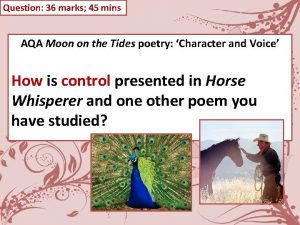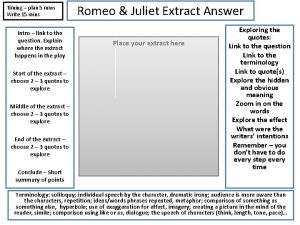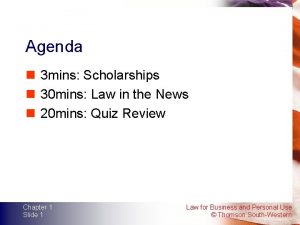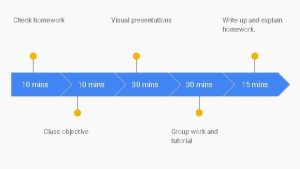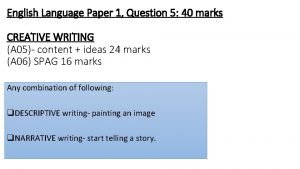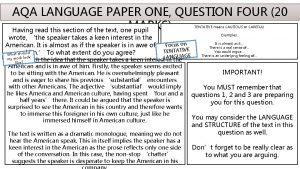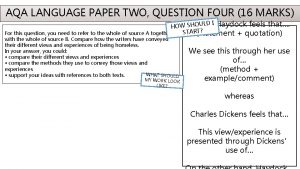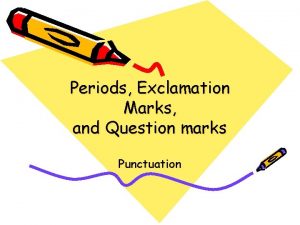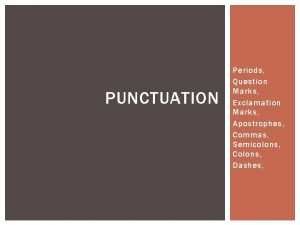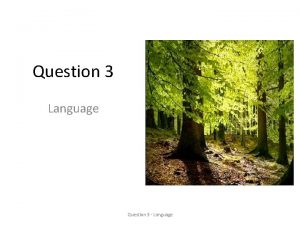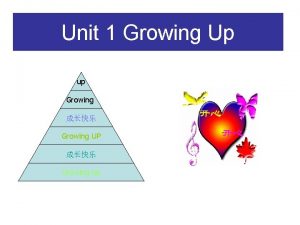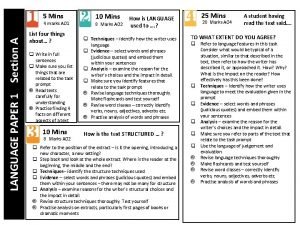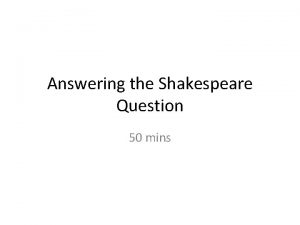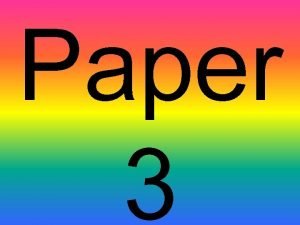Language Paper 2 Growing Up QUESTION MARKS MINS























- Slides: 23

Language Paper 2 Growing Up

QUESTION MARKS MINS Read the questions and annotate source 0 10 Question 1 – True or False 4 5 Question 2 - Select and Synthesise q Source A – 3 PEE paragraphs q Comparative Connective: However, Whereas, In contrast, q Source B – 3 PEE paragraphs q Comparative Overview 8 10 -12 Question 3 – Language Analysis 12 10 -15 16 15 -20 q 4 Technique, Evidence, Effect paragraphs q word classes and phrases q paragraphs on language features q paragraphs on sentence forms Question 4 – Compare Writers’ Ideas and Perspectives q. Overview comparative statement about theme in sources – identify text type/content/tone/purpose/narrative mode of each source q. Source A - Point q. Evidence q. Technique – word classes and phrases, language features and techniques, sentence forms and structure q. Explanation q. Source B - Comparative/Contrastive Point: On the other hand, Source B… q. Evidence q. Technique – word classes and phrases, language features and techniques, sentence forms and structure q. Explanation ESSENTIALLY, IT’S 6 PETER PARAGRAPHS – 3 PETER PARAGRAPHS FOR EACH SOURCE




QUESTION 2: AO 1: Identify, Interpret, Select and Synthesise Level 4 Perceptive, detailed 7 -8 marks Level 3 Clear, relevant 5 -6 marks Level 2 Some, attempts 3 -4 marks Level 1 Simple, limited 1 -2 marks Level 0 No marks Skill Descriptors Shows a detailed understanding of differences between the texts Offers perceptive interpretation of both texts Synthesises evidence between texts Selects a range of judicious quotations from both texts Shows a clear understanding of differences between the texts Begins to interpret both texts Demonstrates clear connections between texts Selects relevant quotations/references from both texts to support response Identifies some differences between the texts Attempts some inference from one/both texts Attempts to link evidence between texts Selects some quotations/references; not always supporting (from one/both texts) Shows simple awareness of difference(s) Offers paraphrase rather than inference Makes simple or no links between texts Simple reference or textual details from one/both texts Candidates in this band will not have offered any differences Nothing to reward

Level? Level 4 Perceptive, detailed 7 -8 marks Level 3 Clear, relevant 5 -6 marks Level 2 Some, attempts 3 -4 marks Level 1 Simple, limited 1 -2 marks Level 0 No marks The activities the boy in Source A likes are being noisy and loud. The things he does are silly, like barking. The boy in Source B is also quite noisy but he has more toys like ‘drums’ to make more noise

Level? Level 4 Perceptive, detailed 7 -8 marks Level 3 Clear, relevant 5 -6 marks Level 2 Some, attempts 3 -4 marks Level 1 Simple, limited 1 -2 marks Level 0 No marks The boy in Source B has lots of toys to play with like ‘drums and tin trumpets’ and ‘little whips’ which can be really noisy. On the other hand, the boy in Source A plays with hardly any toys, mainly because he is younger than the other boy and doesn’t need real toys yet. He likes making noises, but he makes the noise himself using his own voice because it says he ‘barks gibberish in the middle of the room’ instead of playing a musical instrument like the older boy in Source B who is more grown up.

Level? Level 4 Perceptive, detailed 7 -8 marks Level 3 Clear, relevant 5 -6 marks Level 2 Some, attempts 3 -4 marks Level 1 Simple, limited 1 -2 marks Level 0 No marks In Source A the boy is only a year old but still makes his presence felt around the house by making lots of noise, especially when he’s tired. He ‘barks gibberish’ in front of people, which suggests he is immature and likes the attention he gets from showing off. However, the boy in Source B is older and more independent and has real toys to play with, like ‘drums and tin trumpets’, which give him the opportunity to be more musical and more mature, rather than just shouting ‘gibberish’ in the middle of the room like the boy in Source A.

Level? Level 4 Perceptive, detailed 7 -8 marks Level 3 Clear, relevant 5 -6 marks Level 2 Some, attempts 3 -4 marks Level 1 Simple, limited 1 -2 marks Level 0 No marks The activities of the boy in Source A are limited compared to the Victorian boy who has a wider choice of exciting and adventurous games to play. The toddler in Source A enjoys making a noise, exploring the sound effect of his own voice as he ‘barks gibberish in the middle of the room. ’ His noisy outburst takes all his energy as ‘he throws his entire body into it’ showing how, at this self-centred stage of development, he just wants to express himself and attract attention. In contrast, the Victorian boy makes his own noise with ‘a hearty shout’ but has also been given purpose-built musical toys such as ‘drums and tin trumpets’. He is at a different stage of maturity and needs more stimulation to develop his creativity, although perhaps both the boy’s trumpet tooting and the toddler’s ‘gibberish’ are just as irritating for any parent listening.


QUESTION 3: AO 2 – Language Analysis Level Skill Descriptors This question assesses Language ie: Words / Phrases / Language Features / Language Techniques / Sentence Forms Level 4 Detailed, perceptive 10 -12 marks Level 3 Clear, relevant 7 -9 marks Level 2 Some, attempts 4 -6 marks Level 1 Simple, limited 1 -3 marks Level 0 No marks Shows detailed and perceptive understanding of language: • Analyses the effects of the writer’s choices of language • Selects a judicious range of textual detail • Makes sophisticated and accurate use of subject terminology Shows clear understanding of language: • Explains clearly the effects of the writer’s choices of language • Selects a range of relevant textual detail • Makes clear and accurate use of subject terminology Shows detailed and perceptive understanding of language: • Analyses the effects of the writer’s choices of language • Selects a judicious range of textual detail • Makes sophisticated and accurate use of subject terminology Shows simple awareness of language: • Offers simple comment on the effect of language • Selects simple references or textual details • Makes simple use of subject terminology, not always appropriately No ideas offered about differences Nothing to reward

Level? Level 4 Detailed, perceptive 10 -12 marks Level 3 Clear, relevant 7 -9 marks Level 2 Some, attempts 4 -6 marks Level 1 Simple, limited 1 -3 marks Level 0 No marks The writer uses metaphorical language to describe his son as ‘a sleepy ball’, providing the reader with an endearing image of a contented infant curled up, still in the foetal position, suggesting he is very newly born. The adjective ‘sleepy’ conjures up the image of the peace and tranquillity associated with a drowsy baby and a sense of innocence. The phrase ‘scrunched-up flesh’ sounds affectionate but comical, and implies that the child’s individual features are unformed and unrecognisable – he looks just like any other baby.

Level? Level 4 Detailed, perceptive 10 -12 marks Level 3 Clear, relevant 7 -9 marks Level 2 Some, attempts 4 -6 marks Level 1 Simple, limited 1 -3 marks Level 0 No marks The writer starts with a metaphor to describe his new born baby son as ‘a sleepy ball of scrunchedup flesh’. The image of a ’sleepy ball’ gives a sense of the baby curled up, cosy and snuggled, whilst the phrase ‘scrunched-up flesh’ shows how difficult it was to make out his son’s features. The word ‘scrunched’ suggests that the baby’s face is crumpled and creased.

Level? Level 4 Detailed, perceptive 10 -12 marks Level 3 Clear, relevant 7 -9 marks Level 2 Some, attempts 4 -6 marks Level 1 Simple, limited 1 -3 marks Level 0 No marks The writer uses imagery in the phrase ‘a sleepy ball of scrunched-up flesh’ to describe what his son looked like when he was a baby. This is a metaphor and suggests that the baby is curled up and doesn’t really look like a person. When he says ‘scrunched-up’ you can imagine what the baby looks like as it will be all wrinkled.

Level? Level 4 Detailed, perceptive 10 -12 marks Level 3 Clear, relevant 7 -9 marks Level 2 Some, attempts 4 -6 marks Level 1 Simple, limited 1 -3 marks Level 0 No marks The writer uses the words ‘a sleepy ball’ to describe his son as a baby. The phrase makes you think that he looks like a ball and that all he did was sleep. This is a metaphor which means the writer compares one thing to another.


QUESTION 4: AO 3 - Compare writers’ ideas and perspectives Level Skill Descriptors Compare writers’ ideas and perspectives, as well as how these are conveyed, across two or more texts Level 4 Detailed, perceptive 13 -16 marks Level 3 Clear, relevant 9 -12 marks Level 2 Some, attempts 5 -8 marks Level 1 Simple, limited 1 -4 marks Level 0 No marks Shows a detailed understanding of the differences between the ideas and perspectives Compares ideas and perspectives in a perceptive way Analyses how methods are used to convey ideas and perspectives Selects range of judicious quotations from both texts Shows a clear understanding of differences between the ideas and perspectives Compares ideas and perspectives in a clear and relevant way Explains clearly how methods are used to convey ideas and perspectives Selects relevant quotations to support from both texts Identifies some differences between the ideas and perspectives Attempts to compare ideas and perspectives Some comment on how methods are used to convey ideas and perspectives Selects some quotations/references, not always supporting (from one or both texts) Simple awareness of different ideas and/or perspectives Simple cross reference of ideas and/or perspectives Simple identification of how differences are conveyed Simple references or textual details from one or both texts No ideas offered about differences Nothing to reward

Level? Level 4 Detailed, perceptive 13 -16 marks Level 3 Clear, relevant 9 -12 marks Level 2 Some, attempts 5 -8 marks Level 1 Simple, limited 1 -4 marks Level 0 No marks Heritage, a 21 st. C father, is incredulous at how the first year has flown; he ‘blinked’ and the transformation from baby to toddler seemed to happen overnight. There is clearly a tone of fatherly pride as he describes his son’s growing independence; ‘blasting ahead’ suggests he is powering through each stage of development with unstoppable force. The Victorian mother of Source B, however, although perhaps secretly proud of his ‘manly figure, ’ conveys her feelings of sadness that her son no longer needs her: ‘It is a long while now since he disappeared, ’ implying the loss is literal, whereas it is in fact metaphorical - the mother has emotionally, not physically, lost him. She uses a repetitive structure to emphasise her tone of regret. Each paragraph begins with the guests’ views on the positive aspects of life without young children, which is, ironically, the opposite of how the mother feels.

Level? Level 4 Detailed, perceptive 13 -16 marks Level 3 Clear, relevant 9 -12 marks Level 2 Some, attempts 5 -8 marks Level 1 Simple, limited 1 -4 marks Level 0 No marks The writer of Source A, a modern father, is both saddened and pleased by his son’s growth. He finds it difficult to accept that time is moving so quickly; he ‘blinked’ and his son is already a year old. However, the pleasure he feels is also obvious, using phrases like ‘blasting ahead’ to suggest his son is metaphorically taking off like a rocket before his eyes. In contrast, the writer of Source B, who presents a Victorian mother’s perspective, has a negative reaction to her son growing into a young man. She conveys a sense of loss at his independence, even using the phrase ‘My little boy is lost’. By using the word ‘lost’ we understand that she no longer sees herself as part of his life and she regrets that he is no longer dependent on her to ‘replace lost buttons’.

Level? Level 4 Detailed, perceptive 13 -16 marks Level 3 Clear, relevant 9 -12 marks Level 2 Some, attempts 5 -8 marks Level 1 Simple, limited 1 -4 marks Level 0 No marks In Source A the writer is pleased that his son is growing up and doing more. He uses language to describe things he can do and says that his son is ‘blasting ahead’, which suggests that he thinks his son is progressing quickly. On the other hand, in Source B the writer is sad because her son has now grown up. One method she uses to show this is by writing a list of all the things she still wishes she could do for him like ‘replace lost buttons and obliterate mud stains’, suggesting that she misses the way he relied on her for everything.

Level? The writer of Source A feels happy that his Level 4 Detailed, perceptive 13 -16 marks Level 3 Clear, relevant 9 -12 marks Level 2 Some, attempts 5 -8 marks Level 1 Simple, limited 1 -4 marks Level 0 No marks son is getting older. He wants to tell us about all the things his one year old son can now do. He includes lots of examples and uses words like ‘blasting ahead’. However, the writer of Source B isn’t happy about her son growing up. She misses what he was like when he was a baby.

 Www.mathsrevision.com
Www.mathsrevision.com One minute hour
One minute hour Warmup 65
Warmup 65 Growing success achievement chart
Growing success achievement chart Costas level of thinking
Costas level of thinking When do you use exclamation marks
When do you use exclamation marks Brighton rock question 2 model answer
Brighton rock question 2 model answer English language paper 1 question 5 model answer
English language paper 1 question 5 model answer Language
Language Gcse english language paper 1 question 2
Gcse english language paper 1 question 2 Random marks
Random marks Quotations with question marks
Quotations with question marks Do you capitalize aunt
Do you capitalize aunt Paper 2 aice general paper
Paper 2 aice general paper General paper prompts
General paper prompts Human resource management final exam essay questions
Human resource management final exam essay questions Design engineering ktu
Design engineering ktu Principles of question paper setting
Principles of question paper setting Answer these questions on a sheet of paper
Answer these questions on a sheet of paper Question paper moderation tool
Question paper moderation tool Child health nursing gnm 2nd year question paper
Child health nursing gnm 2nd year question paper Sqi english language
Sqi english language Language features
Language features Paper 1 question 4
Paper 1 question 4
